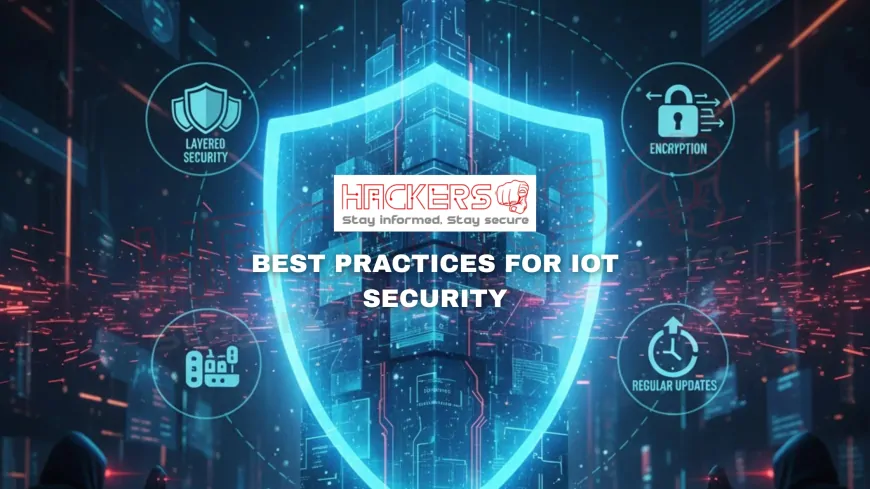What Are the Best Practices for Building Secure IoT Systems?
Imagine a world where your coffee maker wakes you up, your car drives itself, and your home adjusts the temperature before you walk in. This is the magic of the Internet of Things, or IoT. Billions of devices are already connected, from smart thermostats to industrial sensors. But every connection is a potential door for hackers. A single weak link can expose your data, your privacy, or even your safety. The good news? Security doesn’t have to be complicated. Whether you’re a developer, a business owner, or just curious, this guide walks you through proven best practices to build IoT systems that are safe, reliable, and future-proof. Let’s get started.

Table of Contents
- Why Secure IoT Matters More Than Ever
- Design with Security by Default
- Use Unique and Strong Credentials
- Encrypt All Data in Transit and at Rest
- Enable Secure Over-the-Air Updates
- Apply the Principle of Least Privilege
- Segment Devices on the Network
- Require Strong Device Authentication
- Monitor and Log All Activity
- Protect Against Physical Tampering
- Implement Secure Boot and Firmware Validation
- Educate Users and Admins
- Follow Industry Standards and Compliance
- Best Practices Summary Table
- Conclusion
Why Secure IoT Matters More Than Ever
IoT is growing fast. By 2030, over 100 billion devices will be online. These aren’t just phones or computers. They control lights, locks, medical equipment, and power grids. A breach in a smart camera might be embarrassing. A breach in a hospital’s IoT system could be deadly. Weak IoT security has already caused massive botnet attacks, data leaks, and ransomware. Building security from the start saves money, trust, and lives.
- One hacked device can infect thousands
- Privacy laws now punish poor security
- Reputation damage lasts years
Design with Security by Default
Security should not be an afterthought. Build it into every step. Devices should ship with safe settings: no default passwords, encryption on, and remote access off unless needed. Users should not have to “turn on” security. It should be the default behavior.
- Disable unused ports and services
- Ship with unique default passwords
- Require setup wizard to change credentials
Use Unique and Strong Credentials
Never use “admin” or “1234”. Every device should have a unique username and a long, random password generated at the factory. Support password managers and two-factor authentication (2FA) where possible. This stops mass hacking attempts.
- Passwords should be at least 16 characters
- Use hardware-based credential storage
- Rotate keys regularly in enterprise systems
Encrypt All Data in Transit and at Rest
Encryption scrambles data so only authorized devices can read it. Use TLS 1.3 for data in transit (like video from a camera to your phone). Use AES-256 for data at rest (stored on the device or in the cloud). Never send plain text over the internet.
- Check for HTTPS in apps and APIs
- Use end-to-end encryption for sensitive data
- Avoid outdated protocols like SSL
Enable Secure Over-the-Air Updates
IoT devices live for years. New threats appear daily. Allow automatic, encrypted firmware updates over the air (OTA). Sign updates with digital certificates so only official versions install. Never let a device run unsupported software.
- Verify update integrity before install
- Roll back to last known good version if needed
- Notify users of critical security patches
Apply the Principle of Least Privilege
Give each device and user only the access they need. A smart light should not control your front door. A guest app should not see admin settings. This limits damage if one part is compromised.
- Use role-based access control (RBAC)
- Isolate devices in separate network zones
- Revoke access immediately when no longer needed
Segment Devices on the Network
Don’t put all IoT devices on your main network. Use VLANs or guest networks to separate smart bulbs from laptops. If a camera is hacked, it can’t reach your files or bank app.
- Create an “IoT-only” Wi-Fi network
- Block device-to-device communication
- Use firewalls to control traffic
Require Strong Device Authentication
Make sure devices prove who they are before connecting. Use certificates, not just passwords. Mutual TLS (mTLS) lets both device and server verify each other. This stops fake devices from joining your system.
- Issue unique certificates during manufacturing
- Revoke compromised certificates fast
- Support hardware security modules (HSMs)
Monitor and Log All Activity
Track what every device does. Log logins, commands, and errors. Send logs to a secure central system. Use AI to spot unusual behavior, like a thermostat turning on at 3 a.m. React fast to stop attacks.
- Store logs for at least 90 days
- Alert on failed login attempts
- Integrate with SIEM tools for big systems
Protect Against Physical Tampering
Hackers don’t always attack online. They might steal a device or plug in a USB. Use tamper-proof screws, secure enclosures, and sensors that detect opening. Wipe data if tampering is detected.
- Encrypt flash memory
- Disable JTAG debug ports in production
- Use secure elements for key storage
Implement Secure Boot and Firmware Validation
Secure boot ensures only trusted software runs when the device starts. It checks a digital signature on the firmware. If it fails, the device stays off or runs in safe mode. This stops malware from loading at boot.
- Use cryptographic signatures
- Chain of trust from hardware to app
- Update root of trust securely
Educate Users and Admins
Even the best system fails if users click phishing links or share passwords. Teach simple habits: change defaults, avoid public Wi-Fi, and report odd behavior. Provide clear manuals and in-app tips.
- Include security checklist in setup
- Send email alerts for weak settings
- Offer video guides for non-tech users
Follow Industry Standards and Compliance
Standards like ETSI EN 303 645, ioXt, and NIST provide clear security rules. Follow them to meet laws and customer expectations. Get third-party audits to prove your system is safe.
- Comply with GDPR, CCPA, and HIPAA if needed
- Label products with security ratings
- Renew certifications yearly
Best Practices Summary Table
| Practice | Why It Matters | Implementation Tip | Priority |
|---|---|---|---|
| Security by Default | Prevents misconfiguration | Ship with safe settings | High |
| Unique Credentials | Stops mass hacking | Generate at factory | High |
| Full Encryption | Protects data everywhere | Use TLS and AES | High |
| OTA Updates | Fixes new threats | Sign and encrypt | High |
| Least Privilege | Limits breach damage | Use roles and zones | Medium |
| Network Segmentation | Contains attacks | Use VLANs | Medium |
| Monitoring | Detects threats early | Send logs centrally | Medium |
| Secure Boot | Prevents malware boot | Sign firmware | High |
Conclusion
Building secure IoT systems is not optional. It is essential. Start with security by default, strong credentials, and full encryption. Keep devices updated, segmented, and monitored. Use secure boot, tamper protection, and least privilege to lock down access. Follow standards and teach users. These practices are not complex. They are common sense wrapped in technology. Apply them from day one, and your IoT system will stand strong against attacks. The future is connected. Make sure it’s also protected.
What does “security by default” mean?
It means devices are safe to use right out of the box, with no user action needed.
Can small IoT devices handle encryption?
Yes. Modern chips support lightweight encryption like ECC and ChaCha.
Do all IoT devices need updates?
Yes. Even simple sensors can have bugs. Plan for OTA updates from the start.
Is WPA3 necessary for IoT?
Highly recommended. It protects Wi-Fi traffic better than WPA2.
Can I use the same password for all devices?
No. Each device must have a unique, strong credential.
What is least privilege in IoT?
Giving a device only the access it needs to work, nothing more.
Should IoT devices talk to each other?
Only if necessary. Block unnecessary device-to-device communication.
What is secure boot?
A process that checks firmware signature before loading, stopping malware.
Do users need to know about security?
Yes. Simple training prevents phishing and weak password mistakes.
Are there laws for IoT security?
Yes. EU, UK, and California have rules. More are coming globally.
Can budget devices be secure?
Yes, if designed with security in mind. Cost is not an excuse.
What is a hardware security module?
A chip that safely stores encryption keys, even if the device is hacked.
Should I disable debug ports?
Yes, in production. They allow deep access if left open.
Is cloud storage safe for IoT data?
Yes, if encrypted and access is controlled with 2FA and monitoring.
Can IoT devices survive without internet?
Yes. Local control reduces risk. Use internet only when needed.
What is network segmentation?
Splitting your network so IoT devices can’t reach sensitive systems.
Do smart home users need enterprise security?
Not all, but basics like updates, strong passwords, and 2FA are essential.
Can AI improve IoT security?
Yes. It detects unusual behavior fast, like a camera streaming at odd hours.
Should I test my IoT system for security?
Yes. Use penetration testing and code reviews before launch.
Is IoT security a one-time job?
No. It requires ongoing updates, monitoring, and user education.
What's Your Reaction?






























































